Research Article
Good Agriculture Practices Development on Peatland of Myanmar: Case Study to Farmers of Inle Lake and Heho Area
3506
Views & Citations2506
Likes & Shares
Myanmar is poorest country in the Southeast Asia. That will need to develop good agricultural products for people in export as country income. Therefore, this research paper will focus to develop the good agricultural crops like tomato, potato, garlic, etc. particularly peatland area of Inlay Lake and Heho region of Shan State in Myanmar. It will need to observe how to develop good agricultural practices (GAP) on peatland of this region under participation of farmers, traders and consumers along value chain process. This paper presents transforming agriculture of Myanmar applying GAPs, assurance of safe food production and development of GAP standards, strategic development of market linkages, and concept of main guideline principles of GAP in Myanmar. There are applying literature review related with GAP and peatland management, research hypothesis development and 223 farmers sample from 13 villages of Inlay Lake and Heho region, and SPSS software for data analysis. As final part it will express GAP development cum peatland management in terms of policy and strategy development within 10 years of time frame. It will be effective support as Southeast Asia with WRI (Indonesia) who funded on this research in 2021-2022.
Keywords: Good agricultural practices, Peatland management, Safe food production, WRI (Indonesia)
INTRODUCTION
Myanmar is a sovereign state in Southeast Asia bordered by India, Bangladesh, China, Laos and Thailand [1]. Agriculture is an area where Myanmar has a significant comparative advantage, with abundant land and water resources. To date, some floating peats have been found at the region close to Inle Lake, and more in back mangrove areas near the coast. In Myanmar, surveys for peat soil areas are in the beginning stage and the estimated area will be increased after more study with aerial photos, Geographic Information System (GIS), Remote Sensing (RS) methods and ground surveys as well [2].
In Myanmar, it found that the 15 crops are the most consumed and exported such as mango, pomelo, honeydew, watermelon, avocado, chili, tomato, onion, cabbage, potato, various types of beans, sesame, peanut, rice and coffee [3]. Myanmar’s agricultural sector is a key pillar of the economy and provide employment to about 53 percent of the labor force [4]. Thus, it is a source of livelihood for about 70 percent of the rural population as well.
It must have strong practices on good agricultural practices like other neighboring countries of Myanmar. Good Agricultural Practices (GAP) are voluntary guidelines for produce farmers to reduce the risk of microbial contamination related to food borne illnesses on their farms. It must involve the adoption and application of good management principles for the production of wholesome and safe agricultural products for human consumption without affecting the environment and the health of farm workers [5]. According to Myint [2]. the right farming rules and the best agricultural management practices in the peatland of research area through a Good Agricultural Practices. There must respect of farmers on a set of right farming rules and agricultural policy.
It was found in GEF, IUCN [6]. that Myanmar possess peatlands that are used as natural forest, mangrove forest, swamp forest, lake and farm land like Inlay Lake and Heho region of Shan State. Peatlands provide many important ecosystem services, including water regulation, biodiversity conservation, and carbon sequestration and storage [7]. To safeguard these services and mitigate climate change, these highly sensitive areas should be protected from further degradation. Peatlands and organic soils contain 30 percent of the world’s soil carbon but only cover 3 percent of the Earth’s land area. Fifteen percent of peatlands are drained and used for agriculture, grazing, peat mining and forestry, especially for bioenergy plantations. Including emissions from peat fires, these drained peatlands emit almost 6 percent of anthropogenic CO2 emissions.
In Southeast Asia, the deep drainage required for common land uses, such as oil palm plantations and Acacia cultivation for wood pulp, with consequent high peat oxidation rates is expected to result in serious flooding within a few decades due to subsidence [8]. In tropical climates with over 2000 mm of annual precipitation, pump operated drainage will not be feasible. While the use of drained peatland may lead to significant short term economic profits, its inherent unsustainability may have severe long term socio-economic consequences, not only in relation to its disproportionately large contribution to climate change.
Problem Statement of this Research
To achieve the goal of GAP at the national, there are requirements for fully practicing the guidelines nationwide. The guidelines will support to increase the agricultural productivity, market access and competitiveness of the agricultural sector by improving the provision of quality inputs to farmers.
Heho and Inle Lake regions were locally accepted as peatland for their topographical and hydrological situation. In those areas, peatland soils were widely used for agriculture. In contrast of this, there has lack of awareness to wise-use and sustainable management through environmental protection on watershed area and peatland of key villages in Inle Lake.
Therefore, Inle Lake has been facing with environmental degradation and dangerous agricultural practices for low agricultural income for farmers, mainly affected to nearly 40 villages around and inside of this. Floating tomato cultivators in Inle Lake are poor experiences with the GAP system, thus it will still essential to assist on providing GAP technology and conducting demonstration sessions on the use of bio pesticides to main villages on peatland of Lake.
Hopefully, this research intends to promote environmental protection of Inle Lake and agricultural productivity at least 20%-30% impact in terms of practices, policy level of Governance and CSOs as well to consider long term action plan for Myanmar Government (Agricultural Ministry, Forest Conservation Ministry), private sectors of agricultural business and NGOs like RECOFTC, TNC, and FAO as well.
Research Objectives
Good agriculture practices development for environmental protection and economic promotion in peatland of Myanmar like Inle Lake and Heho area of Shan State. It can be useful for farmers, community, particularly living inside and around peatland through appropriate policy, strategy and technology in agricultural growing, processing and marketing as well.
Specific research objectives will be;
- To assess current situations of GAP practices in Inlay Lake and Heho’ villages
- To improve GAP practices in these villages
- To promote livelihood of villagers who are relying of agricultural products
- To assess potential peatland protection measures
- To suggest policy, strategy for GAP development and peatland management in Myanmar
LITERATURE REVIEW
Sustainable food production and agricultural systems that are resilient to climate change will be crucial for developing Asia [9]. Innovative solutions are essential to increase the productivity of developing Asia’s smallholder farmers.
Asia must transform agriculture to tackle the most emerging challenges like changing demand, changing demographics and changing the fragile environment. Food demand is increasing and shifting toward animal products, requiring more resource-intensive agriculture. Meanwhile, Asia struggles to improve agricultural productivity as rural populations shrink and age. Further, agriculture is exposed to risks from a changing climate and from farm practices that damaged environments.
Due to the growing demand for higher quality and safer food products by consumers, it has become more common for both importing countries and domestic buyers to require certification for the use of good agricultural practices (GAP) in food production and distribution [10]. Thus, Association of Southeast Asian Nations (ASEAN) countries have a common GAP framework for the production, harvesting and postharvest handling of fresh fruits and vegetables (ASEAN GAP). This ASEAN GAP aims to prevent or minimize hazards associated with food safety, environmental impacts, worker health, safety and welfare, and product quality.
However, as the misconception of GAP has hindered the introduction and adoption of GAP practices. There is a belief that GAP standards are restrictive and obstruct farmers and their agriculture processes [11]. However, the fundamental guiding principal of GAP will be the achievement of a safe and sustainable food production system for growers and consumers. This safe production system is necessary to ensure the rights of consumers to hygienic, nutritious, and affordable food.
In addition, as supermarket expansion in Asia continues with more direct sourcing from farms, there are greater opportunities for small and rural farmers to directly participate in the mainstream market system [12,13]. Supermarkets have also argued that the reduction of marketing intermediaries will reduce distribution costs and that the savings could be returned to farmers.
Private sector’s actions of the large food production-corporations response to consumers’ sensitivities about food safety and environmental sustainability [14]. Unilever is one of the largest consumer goods companies in the world. It is the world’s largest user of agricultural raw materials [15] and a major buyer of agricultural goods for processing for the world markets. The company is one of the largest producers of tomato-based sauces, pasta, and frozen peas and spinach [16].
Thus, the initiative produced the agricultural best practice guidelines that have been incorporated into Unilever’s contracts with their growers, defining soil preparation, fertilization regimes, harvesting, and other activities specific to each crop. This initiative thus plays an active role in influencing GAP for farmers. On the other hand, there is also competition among supermarket chains to secure supplies from producers with the best quality agri-food products at the best prices. Increased global competition can be traced to new seed varieties and technology.
GAP certification is a verification method that proves that farmers understand the principles of GAP, and are willing and able to abide with the rigors of good farm practices. According to Antequera [17] there are three levels of certification processes: As First party certification process that must be with supplier’s design and comply with their own food safety program standards and suppliers hire an independent certification team to audit their operations and quality. In Second party certification process that suppliers are required to comply with food safety schemes from buyers and these standards are designed by the buyers. Standards compliance and supplier operations are audited by the buyers or by independent certification bodies or auditors. For third party certification process, buyers adopt an independent food safety scheme for themselves and the suppliers [18]. Consequence of this, the buyers or suppliers hire an independent certification body to audit the suppliers.
At the moment, all GAP certification is voluntary. GAP standards are not a form of regulation. Certification simply proves that GAP standards have been followed.
- Enhanced food safety through the improvement of coordination with suppliers
- Reduction of risks and liabilities in production, leading to fewer recalls and withdrawals of products during distribution
- Improved cost management and good practices for IPM
- Improved productivity through the introduction of efficient operations management
- Competitive advantages related to costs, the market, credibility, and price
- Market access and recognition by buyers
- Improvements of farm ecology through good management of input resources
Southeast Asia has more than 25 million ha of peatlands or 60% of the known tropical peatland resource. However about two-thirds of the peatlands are heavily utilized or degraded and, over the past 10 years, more than three million ha have burnt [19]. Thus, it generated smoke clouds covering up to five countries, causing economic losses of billions of dollars and triggering major health and environmental concerns. Deforested and drained peatlands in Southeast Asia are also a globally significant source of CO2 emissions, equivalent to almost 8% of global emissions from fossil fuel burning.
The major characteristics of natural peatlands are permanent water logging, the formation and storage of peat, and the continuous upward growth of the surface. The special characteristic of lowland tropical peatland is peat swamp forest (part of the rainforest formation) growing on top of and contributing to the accumulation of a thick surface layer of peat which can exceed 20 meters in depth. The forest is the carbon allocating machinery that forms a biomass carbon store comparable to that of other rainforest types, whilst the waterlogged, acidic and nutrient deficient substrate, on which it grows, creates conditions under which the rate of biomass decomposition is reduced greatly and peat accumulates [3].
In peatland products include provision of water supply to other ecosystems and human communities, forest resources ranging from fuelwood, timber and bark to resins and medicines, wildlife resources, agricultural and horticultural resources, and energy resources [20].
RESEARCH METHODOLOGY
This research type is ‘Descriptive vs. Analytical’ that includes surveys and fact-findings enquires of different kinds for GAP and peatland management in Inlay Lake and Heho region of Shan State. The major purpose of descriptive research will describe the state of affairs as it exists at present in research study area of Myanmar. The main characteristics of this method is that research team has no control over the variables, it can only report what has happened or what is happening in GAP practices, traditional agricultural practices, peatland situation cases through farm land or conservation practices by local farmers, agricultural department and forest department as key stakeholders.
A total of 223 respondents are interviewed with questionnaires who lived in 13 villages located in Inlay Lake and Heho region during November of 2021. It is really challenging to travel and appointment due to Covid-19 outbreak in most villages of study area.
Characteristics observed villages in the study area
Inlay Lake is located in Southern part of Shan State along mountainous region and Heho region is near the lake, both areas have peatland and prior to GAP practices since 2019 to now. It is pioneer area for GAP development and peatland management by UN organizations, NGOs and donors’ interest in assessment, feasibility and actions programme.
Research study area is located on the Shan plateau of east Myanmar, in Thanlwin River Basin. Inle lake is situated between two limestone mountain ranges over 5000 feet (1500m) high. It has significant value for biodiversity, hydrology, soil/carbon, cultural & historical value and socio-economic. During the past 40 years, the landscape surrounding Inle Lake has undergone dramatic changes mainly caused by an intensification of agriculture, deforestation and urbanization. Shifting cultivation and deforestation process affect about 80% of the total catchment surface area. Addition to this, the fresh water ecosystem is threatened by water pollution and sedimentation due to slash and burn farming techniques on the surrounding hills, intensive vegetable production on floating gardens, which were introduced in the early 1960s (Figure 1).
Excessive fuelwood cutting, shortened fallow periods for shifting cultivation, inefficient cultivation practices and uncontrolled livestock grazing have led to severe loss of soil organic matter and poor water retention.
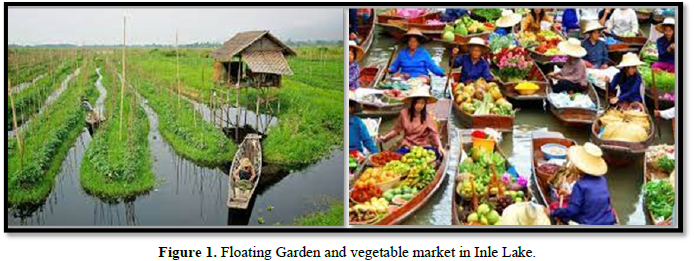

Floating gardens are based on floating, man-made islands composed of decayed grasses, reeds and marsh plants. The islands (locally known as Ye-chan) are typically about 2 m wide and 40 m long, but may reach up to 800 m2. Silt and clay alluvium from the lake bottom and weeds such as water hyacinth are used to augment the structure and fertility of these islands. By trimming these islands annually, Inle Lake farmers (Inthas) grow vegetables year-round. Tomato (Lycopersicon esculentum L.) is the main cash crop on these islands. In recent years, a very productive tomato variety has been introduced from Thailand and Inle Lake has become a major production area of the country. Floating islands are cultivated approximately 15 years dependent on the floatability of the submerged mattress of vegetation.
13 villages are selected, namely as ‘Aing Htaunt Gyi’ (20 respondents), ‘Kyay Sar South’ (32 respondents) , ‘Kyay Sar North’ (32 respondents), ‘Ye Thar (14 respondents)’, ‘Nga Phe Chaung (21 respondents)’, ‘Lwe Thit Htet (15 respondents)’, ‘Lwe Thit Auk (19 respondents)’, ‘Myay Pwe Auk’ (19 respondents), ‘ Lwemaw (Than Taung)’ (15 respondents), ‘Mong Thauk (14 respondents)’, ‘Lwe Maw (Than Taung)’, ‘Taung Poet Gy(13 respondents), ‘Heho (Myet Set Htaung)(18 respondents), and ‘Heho (Waryone Pin)’(13 respondents) (Figure 2).
Perceived conceptual framework
This study will support GAPs agricultural products for farmers, its lake environment and peatland area of Myanmar according to research advice and following up actions of international organizations and Myanmar Government as well (Figure 3).
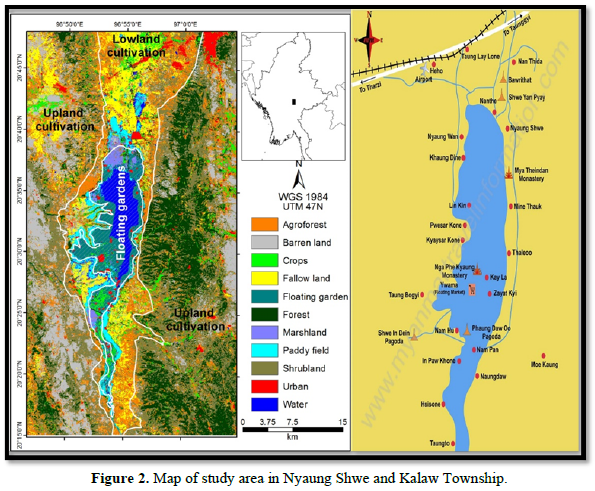
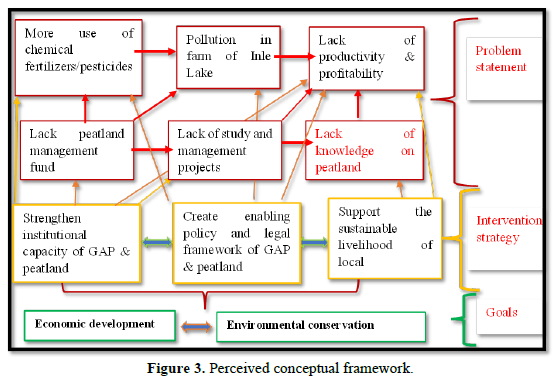
DISCUSSIONS ON FINDINGS
According to ‘Reliability Statistics’ result, the ‘Cronbach’s Alpha’ is 0.709 upon the 64 number observed items with research questionnaires is acceptable as shown in following Table. Therefore, it is higher level of acceptable while the reliability statics above 0.7 of ‘Cronbach’ Alpha’ while 223 respondents related data and variables (Table 1).

Respondent farmers’ socioeconomic status (Gender, Age, Ethnic, Religion, Marital status, Family members, Education, Occupation)
It is necessary to study social status of villagers who are key farmers or potential farmers to participate in GAP agriculture and peatland management near their villages. Their participation, attitude and behavior changes are related or influenced by their social status and economic benefits while planning strategy, actions or along the operational implementation process.
There are summary of socioeconomic findings and discussion’ Table 2.
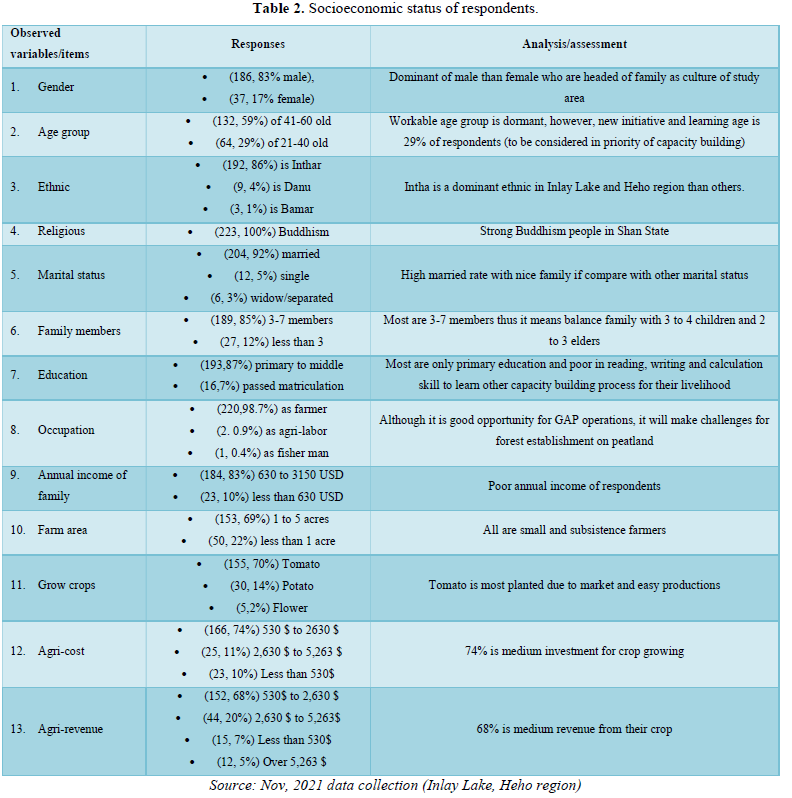

Perspective upon GAP
It is observed the perception of farmers upon GAP as following Table and Figure related with ‘Understanding on GAP’, ‘Preference GAP’, ‘Export GAP crop’, ‘Healthy crop production’ etc. Most of respondents are ‘Preference GAP’ on their farm with 177 respondents (77%). Furthermore, most (63% of respondents) believes that it can create economic opportunity for women (Figures 4 & 5).
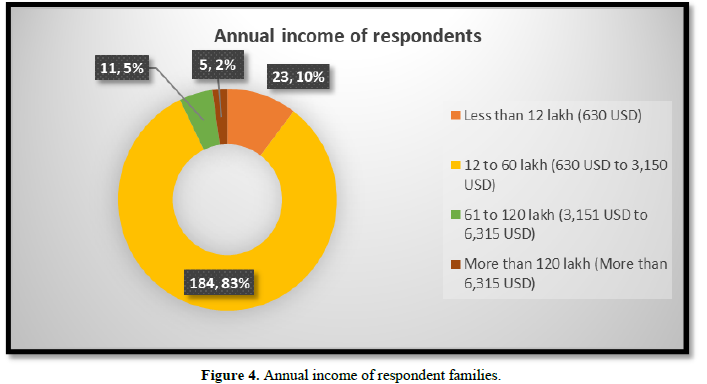
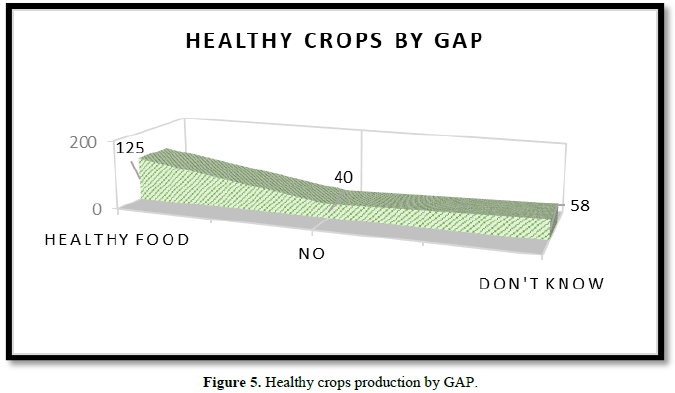


Needed capacity building trainings for GAP
This research also learnt what kinds of capacity building training for GAP. Most people like to attend ‘GAP operational techniques’ properly than other trainings. Actually, it is more essential to improve marketing skill for them. It will need capacity building training work plan while GAP programme starting. (Figure 6).
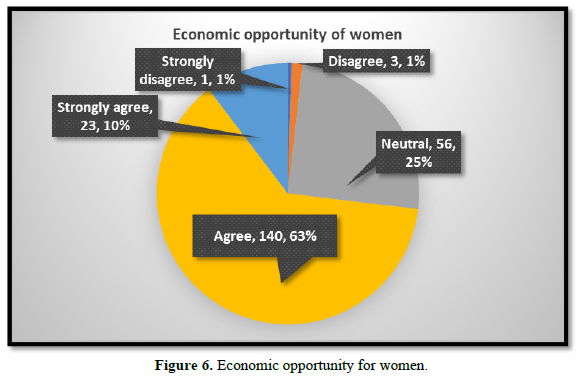

Organic pesticide making and applying training will support organic food and GAP certification process as well. However, most respondents are not interested in this. It should be practiced in farms of Inlay Lake due to more water pollution in lake by inorganic pesticide using for decades (Tables 3 & 4).
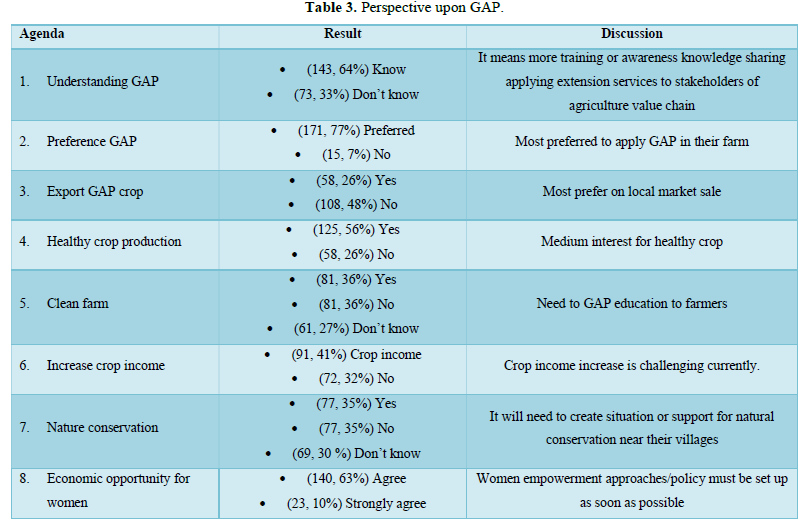
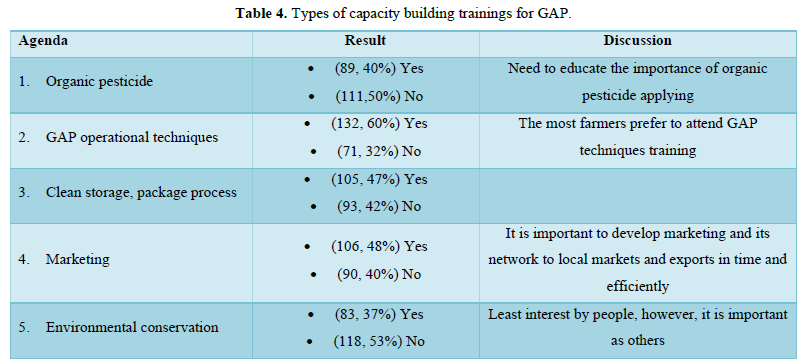


Need assistance for GAP improvement in future
Although farmers are interested to apply GAP, it will need more support as initial stage and developing process. These are defined as ‘Women leading’, ‘Agricultural investment support’, ‘Consumer cooperation’, etc. In reality, agricultural sector must be the women’ leading roles and operational management roles than men farmers. In addition, consumer must cooperate in GAP and agricultural production in terms of marketing, fair price, value added products, social support, advices, etc. (Figure 7).
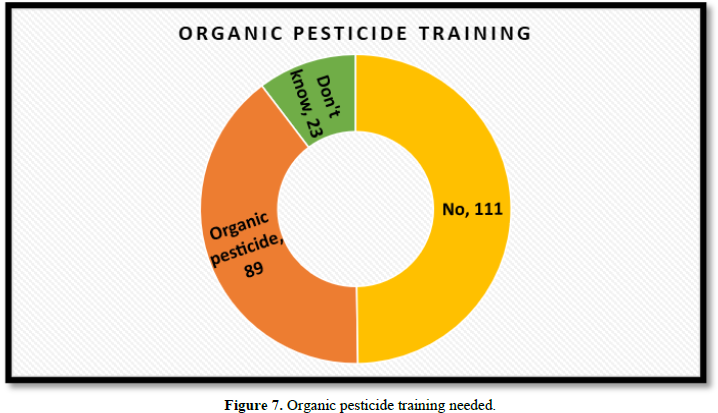

Most are farmers are poor than other livelihood people in Myanmar as well as in Inlay Lake. Thus, every year, they request loan for agricultural inputs and due to politics and country economic sinking since 2020 to now, most farmers cannot grow crops or less grow than their capability efforts. GAP is new practice and they are reluctant to apply this than traditional agricultural practices (Table 5).
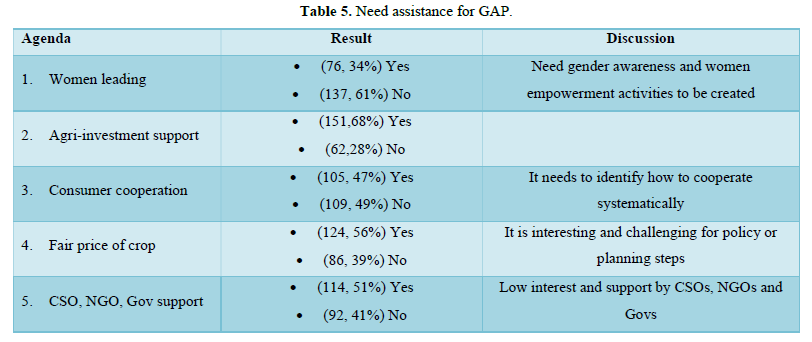

Therefore, some farmers will need partial cash support to develop GAP on their farms. Or, it will need agricultural loan from microfinance institution for crop grows, marketing and value-added production like preserved tomato, fried potato, and ready-made vegetables varieties as demand of shopping malls in Yangon and Mandalay Capital.
GAP supports to peatland management in study area
GAP farming can support peatland management of Inlay Lake and Heho region where located peat soil as farm, pasture land and under shallow water of around the lake. There has high risk of pollution due to bad farming practices all of Shan State (Figure 8).
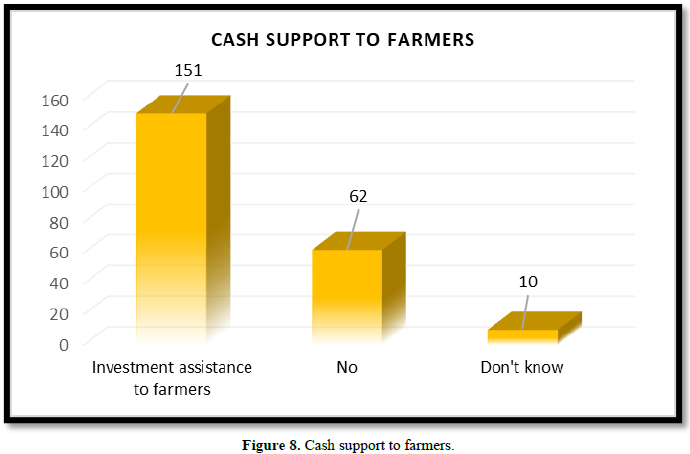
GAP can mitigate water pollution and soil pollution due to its responsible agricultural practices for farmers, consumers and environmental concerns (Table 6).
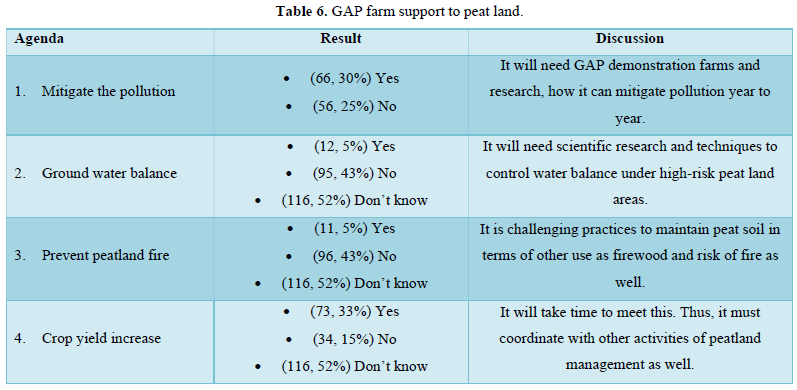

Villagers support to peatland management
This research also assesses the available support to peatland management by villagers. 39% of respondents are interested to plan trees on and around the peatland of study area. ‘Reduce fertilizer/pesticide use’ is more interested supporting activities by villagers with 50% of respondents as following (Table 7).
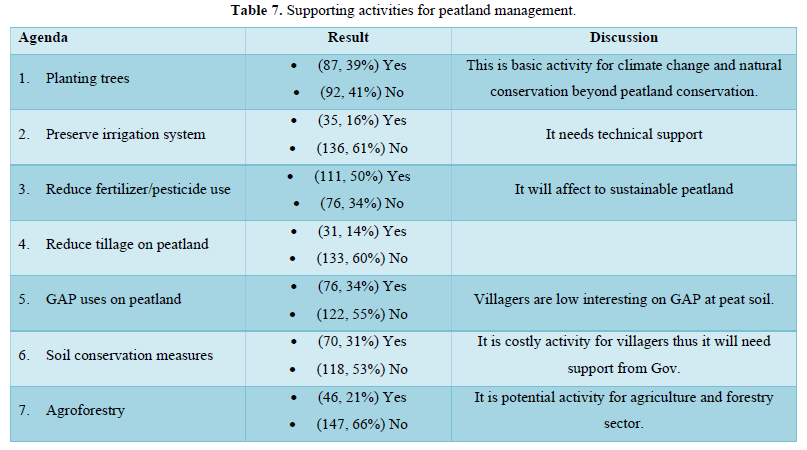

RECOMMENDATIONS
These recommendations will be based on findings and discussions related on GAP and peatland management of Inle Lake and Heho region.
- Male dominant culture is found and it will need to improve gender awareness and women empowerment activities before operating GAP and peatland management.
- These study villages have the young age families and balance of family members workforce to implement livelihood activities and environmental conservation
- Most IEC must be developed ‘Intha’ language and culture due to dominant ethnic in this.
- All are Buddhism, that must fully respect religious norm, culture and practices while implementing GAP and peatland conservation
- It will need to basic education level of future generation under cooperation with education department due to poor education level of villagers
- Poverty is found and other alternative livelihood or loan for agricultural related SMEs are essential in these villages.
- Tomato is a main crop planted and it should have prioritized actions for fair marketing and value-added productions than other crops
- If agriculture yields want to increase, it will need loan for agricultural inputs due to most farmers are applying medium
- GAP trainings must be provided and coaching will be followed up to some pilot farmers. Some farmers need to organize to grow as international market level than local market demand and quality crops.
- ‘GAP techniques’ training should be provided and it should select women than men farmers.
- ‘Women leading’ in GAP and peatland management will have some challenges due to culture, social practice and capability of women. It can be overcome by applying policy and strategy of Gov and NGOs.
- Prices of crops are very low to meet the marginal profits, thus it will need to implement crop insurance and subsidize scheme should be introduced
- There is low interest and support to GAP and peatland management, thus it will need more R&D from international academic institutions like WRI, TNC, RECOFTC, UN organizations.
- Prevent peatland fire will be necessary of community participation and CSOs leading roles to organize local farmers and other land users to follow up rules and regulations of natural resources.
- It is interesting social empowerment and cohesion approach through planting campaign, organic fertilizer using, GAP network on the peatland area of Inle Lake and Heho region.
- Agroforestry must be set up policy interventions and support on peatland management system.
ACKNOWLEDGEMENT
I would like to thank WRI (Indonesia) team based in Jakarta, and all research assistant U Myint Zaw and team as well as all respondents’ farmers and SMEs owners of Inlay Lake and Heho region. Simply, without their supports, this research cannot be end gain as objectives of this.
- Florento H, Corpuz MI (2014) Myanmar: The key link between South Asia and Southeast Asia Manila ADB Institute. Available online at: http://www.adbi.org/workingpaper/2014/12/12/6517.myanmar.key.link.south.southeast.asia/
- Myint DK (2019) Best Management of Peatland in Myanmar Experience of Agriculture on Peatland A case study of Taung Poe Gyi village Nay Pyi Taw Yezin Agricultural University.
- RCDP (2020) Myanmar Resilient community development project Market opportunities for livelihood development RCDP.
- IFC (2017) IFC Supports Myanmar’s Agricultural Sector to Improve upon its Productivity and Quality. Available online at: https://pressroom.ifc.org/all/pages/PressDetail.aspx?ID=17472
- CAFHSA (2021) Good Agricultural Practices. Available online at: https://www.cahfsa.org/2-uncategorised/38-good-agricultural-practices
- GEF, IUCN (2018) Sustainable management of peatland ecosystems in Mekong Countries International Union for Conservation of Nature. Available online at: https://www.iucn.org/sites/dev/files/esmp_peatland_mekong_update_apr2019.pdf
- Joosten H (2012) Peatlands guidance for climate change mitigation through conservation, rehabilitation and sustainable use Rome Food and Agriculture Organization & Wetland International.
- Wetlands International (2016) Wetlands International to highlight soil subsidence and flooding at International Peat Congress. Available online at: https://www.wetlands.org/news/wetlands-international-to-highlight-soil-subsidence-and-flooding-at-international-peat-congress/
- Abiad A (2021) Asian development outlook 2021 update Transforming agriculture in Asia. Manila Asian Development Bank. Available online at: https://www.adb.org/sites/default/files/publication/726556/ado2021-update.pdf
- ADB (2020) Development of standards and scheme for good agricultural practices GAP implementation and certification based on ASEAN GAP Manila Asian Development Bank. Available online at: https://www.fao.org/3/cb1303en/CB1303EN.pdf
- Sareen S (2017) Introduction to GAPs and experience from SAARC countries Introduction and initiation Beirut Arab GAP stakeholders of Jordan. Available online at: https://www.unescwa.org/sites/default/files/event/materials/003_-_introduction_to_gaps_and_experience_from_south_asian_countries_introduction_and_initiation.pdf
- Shepherd WA (2005) The implications of supermarket development for horticultural farmers and traditional marketing systems in Asia Rome FAO. Available online at: http://nishorgo.org/wp-content/uploads/2017/04/2-1-4-31-FAO-Supermarket-paper-Shepard.pdf
- Reardon T, Timmer CP, Minten B (2012) Supermarket revolution in Asia and emerging development strategies to include small farmers. PNAS 109: 12332-12337.
- WHO (2021) WHO Global Strategy for Food Safety 2022-2030? Towards stronger food safety systems and global cooperation. Available online at: https://cdn.who.int/media/docs/default-source/food-safety/public-consultation/draft-who-global-strategy-for-food-safety-13may2021.pdf?sfvrsn=ac480bb9_5
- Voora V (2020) Global market report Palm oil IISD SSI. Available online at: https://www.iisd.org/system/files/publications/ssi-global-market-report-palm-oil.pdf
- Unilever (2018) Putting the green in tomato sauce. Available online at: https://www.unilever.com/news/news-search/2018/putting-the-green-in-tomato-sauce/
- Antequera I (2017) Global GAP implementation and certification process Global GAP. Available online at: https://www.globalgap.org/export/sites/default/.content/.galleries/Documents_for_Mailings/170704_GG_Implementation.pdf
- GFSI (2018) Enhancing food safety through third party certification. The Consumer Goods Forum & GFSI. Available online at: http://mygfsi.com/wp-content/uploads/2019/09/Third-Party-Certification-GFSI-White-Paper.pdf
- Prentice R (2011) The Peatland biodiversity management toolbox A handbook for the conservation and management of peatland biodiversity in Southeast Asia. Jakarta The ASEAN Secretariat. Available online at: http://www.aseanpeat.net/ebook/toolbox/The_Peatland_Biodiversity_Management_Toolbox.pdf
- Jennings S (2017) Beyond forests Reducing the EUs footprint on all natural ecosystems WWF. Available online at: https://www.wwf.de/fileadmin/fm-wwf/Publikationen-PDF/Wald/WWF-Report-Beyond-Forest.pdf
QUICK LINKS
- SUBMIT MANUSCRIPT
- RECOMMEND THE JOURNAL
-
SUBSCRIBE FOR ALERTS
RELATED JOURNALS
- Journal of Microbiology and Microbial Infections (ISSN: 2689-7660)
- Journal of Genetics and Cell Biology (ISSN:2639-3360)
- Journal of Veterinary and Marine Sciences (ISSN: 2689-7830)
- Journal of Genomic Medicine and Pharmacogenomics (ISSN:2474-4670)
- Proteomics and Bioinformatics (ISSN:2641-7561)
- Food and Nutrition-Current Research (ISSN:2638-1095)
- Advances in Nanomedicine and Nanotechnology Research (ISSN: 2688-5476)









